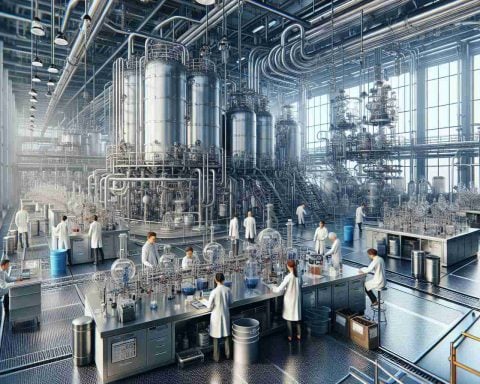- Breakthroughs in agricultural technology are being developed at Northeastern University under Assistant Professor Qing Zhao’s leadership.
- The research focuses on creating a sustainable future for fertilizer production using quantum mechanics and machine learning.
- Zhao’s team is working on eco-friendly ammonia production, aiming to reduce dependencies on fossil fuels.
- The goal is to harness solar and wind energy for chemical reactions at ambient temperatures, facing challenges in achieving commercial efficiency.
- Advanced computational models enable the exploration of lithium-mediated nitrogen reduction reactions, overcoming traditional experimental limitations.
- The research could significantly reduce the carbon footprint of fertilizers, contributing to more sustainable agriculture.
- The work is recognized by the National Science Foundation, highlighting its potential industry impact.
In a bustling computational lab at Northeastern University, breakthroughs in agricultural technology are unfolding. Here, amidst the hum of computers, Assistant Professor Qing Zhao is at the frontier of creating a more sustainable future for fertilizer production. Her pioneering research delves into the heart of chemical engineering, employing the precision of quantum mechanics and the power of machine learning to redesign catalysts at the atomic level.
Zhao’s team ventures into ambitious realms such as transforming carbon dioxide into fuel and recycling plastic waste. Yet, their current obsession is one of agriculture’s vital components: ammonia. This essential element of fertilizers is typically produced under extreme conditions, burning fossil fuels and belching carbon dioxide. However, Zhao has a different vision—one where ammonia production aligns with environmental imperatives.
The journey to eco-friendly ammonia involves harnessing nature’s own forces, using solar and wind energy to trigger chemical reactions at ambient temperatures. The challenge, however, lies in efficiency, as current methods fall short of commercial viability. Here is where Zhao’s computational prowess shines. By exploring the potential of lithium-mediated nitrogen reduction reactions, she hopes to unravel the mysteries hidden at the microcosmic level.
Her lab’s digital models bypass the limitations of traditional experimental tools, offering a clearer picture of the rapid, elusive reactions. For Zhao, this is not just academic pursuit; it is an opportunity to redefine an industry. Her work, recognized by the National Science Foundation, aims to reduce fertilizer’s carbon footprint, offering a glimmer of hope for a more sustainable agricultural landscape. As her team forges ahead, the promise of greener farming surges ever closer.
Revolutionizing Fertilizer Production: A Quantum Leap Towards Sustainable Agriculture
The Push for Greener Ammonia Production
The article highlights significant strides in sustainable agriculture through the work of Assistant Professor Qing Zhao at Northeastern University. Her research focuses on developing eco-friendly methods of producing ammonia, which is a crucial component in fertilizers, by employing advanced chemical engineering techniques, including quantum mechanics and machine learning. This work is integral to reducing the carbon footprint of agriculture.
Additional Relevant Information
1. Global Ammonia Production Impact: Traditional ammonia synthesis, primarily through the Haber-Bosch process, is responsible for about 1% of global CO2 emissions. This substantial environmental impact makes the search for sustainable production methods urgent and impactful on a global scale.
2. Scientific Innovation: The research’s emphasis on lithium-mediated nitrogen reduction reactions as an alternative to conventional processes represents a novel scientific advancement. Such methods, if successful, could revolutionize chemical manufacturing, impacting industries far beyond agriculture.
3. Environmental Influence: Transforming the process of ammonia production has the potential to significantly mitigate environmental pollution. By employing renewable energy sources like solar and wind for the chemical reactions, the dependency on fossil fuels decreases, aligning with global initiatives for reducing greenhouse gas emissions.
4. Economic Alternatives: Should Zhao’s methods achieve commercial viability, they could reduce the costs associated with fertilizer production, potentially lowering agricultural costs and stabilizing food pricing globally. This economic aspect would be particularly beneficial for developing countries, where agriculture forms a substantial portion of the economy.
5. Technological Advancements: Zhao’s use of machine learning to predict and analyze the reactions at an atomic level illustrates the broader integration of artificial intelligence in scientific research. This integration could accelerate discovery in various fields beyond chemistry, such as medicine and environmental science.
Key Questions and Answers
Why is ammonia production so vital to agriculture?
Ammonia is essential for creating fertilizers, which are crucial for maintaining soil fertility and ensuring high crop yields, thereby supporting global food production.
What are the broader implications of sustainable ammonia production?
Apart from reducing emissions, sustainable ammonia production can decrease energy consumption, offer technological advancements, and potentially transform other industrial sectors reliant on ammonia.
How does Zhao’s research integrate renewable energy?
Zhao’s team is leveraging solar and wind energy to initiate the chemical reactions necessary for ammonia production, reducing the reliance on fossil fuels and enhancing environmental sustainability.
What challenges still exist for Zhao’s research to become commercially viable?
Efficiency remains a significant challenge, as current methods of sustainable ammonia production often do not match the yields of traditional processes, hindering large-scale adoption.
Further Reading
For those interested in the technological and environmental impacts of this research, explore more through these related resources:
– Northeastern University
– National Science Foundation
Understanding the potential transition to a sustainable agricultural landscape not only offers a glimpse into the future of farming but also urges industries to consider environmental imperatives as they forge ahead.













